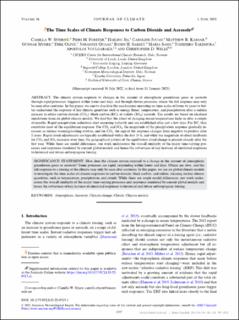| dc.contributor.author | Stjern, Camilla Weum | |
| dc.contributor.author | Forster, Piers M. | |
| dc.contributor.author | Jia, Hailing | |
| dc.contributor.author | Jouan, Caroline | |
| dc.contributor.author | Kasoar, Matthew R. | |
| dc.contributor.author | Myhre, Gunnar | |
| dc.contributor.author | Oliviè, Dirk Jan Leo | |
| dc.contributor.author | Quaas, Johannes | |
| dc.contributor.author | Samset, Bjørn Hallvard | |
| dc.contributor.author | Sand, Maria | |
| dc.contributor.author | Takemura, Toshihiro | |
| dc.contributor.author | Voulgarakis, Apostolos | |
| dc.contributor.author | Wells, Christopher D. | |
| dc.date.accessioned | 2024-03-05T11:34:16Z | |
| dc.date.available | 2024-03-05T11:34:16Z | |
| dc.date.created | 2023-07-13T10:04:54Z | |
| dc.date.issued | 2023 | |
| dc.identifier.citation | Journal of Climate. 2023, 36 (11), 3537-3551. | en_US |
| dc.identifier.issn | 0894-8755 | |
| dc.identifier.uri | https://hdl.handle.net/11250/3121077 | |
| dc.description.abstract | The climate system responds to changes in the amount of atmospheric greenhouse gases or aerosols through rapid processes, triggered within hours and days, and through slower processes, where the full response may only be seen after centuries. In this paper, we aim to elucidate the mechanisms operating on time scales of hours to years to better understand the response of key climate quantities such as energy fluxes, temperature, and precipitation after a sudden increase in either carbon dioxide (CO2), black carbon (BC), or sulfate (SO4) aerosols. The results are based on idealized simulations from six global climate models. We find that the effect of changing ocean temperatures kicks in after a couple of months. Rapid precipitation reductions start occurring instantly and are established after just a few days. For BC, they constitute most of the equilibrium response. For CO2 and SO4, the magnitude of the precipitation response gradually increases as surface warming/cooling evolves, and for CO2, the sign of the response changes from negative to positive after 2 years. Rapid cloud adjustments are typically established within the first 24 h, and while the magnitude of cloud feedbacks for CO2 and SO4 increases over time, the geographical pattern of the equilibrium cloud change is present already after the first year. While there are model differences, our work underscores the overall similarity of the major time-varying processes and responses simulated by current global models and hence the robustness of key features of simulated responses to historical and future anthropogenic forcing. | en_US |
| dc.language.iso | eng | en_US |
| dc.publisher | AMS American Meteorological Society | en_US |
| dc.rights | Navngivelse 4.0 Internasjonal | * |
| dc.rights.uri | http://creativecommons.org/licenses/by/4.0/deed.no | * |
| dc.subject | Atmosphere | en_US |
| dc.subject | Aerosols | en_US |
| dc.subject | Climate change | en_US |
| dc.subject | Clouds | en_US |
| dc.subject | Climate models | en_US |
| dc.title | The Time Scales of Climate Responses to Carbon Dioxide and Aerosols | en_US |
| dc.title.alternative | The Time Scales of Climate Responses to Carbon Dioxide and Aerosols | en_US |
| dc.type | Peer reviewed | en_US |
| dc.type | Journal article | en_US |
| dc.description.version | publishedVersion | en_US |
| dc.source.pagenumber | 3537-3551 | en_US |
| dc.source.volume | 36 | en_US |
| dc.source.journal | Journal of Climate | en_US |
| dc.source.issue | 11 | en_US |
| dc.identifier.doi | 10.1175/JCLI-D-22-0513.1 | |
| dc.identifier.cristin | 2162209 | |
| dc.relation.project | Norges forskningsråd: 229771 | en_US |
| dc.relation.project | Norges forskningsråd: 270061 | en_US |
| dc.relation.project | Norges forskningsråd: 295046 | en_US |
| dc.relation.project | Sigma2: NN2345K | en_US |
| dc.relation.project | Sigma2: NS2345K | en_US |
| cristin.ispublished | true | |
| cristin.fulltext | original | |
| cristin.qualitycode | 2 | |

